Companies can leverage the true value of meetings with AI by building an ‘LLM for Leadership’
Are you getting more out of your meetings than ever before? You should be. Meetings remain an inevitable practice for organizations large and small. The practice dates back to the days of Socrates and Plato in ancient Greece but we have new tools and technology today that should mean more effectiveness and a much higher return on the investment in the time spent in meetings. Many teams still conduct meetings like the ancient Greeks gathering at the Agora. While Socrates famously opposed writing — believing it would weaken memory and was inferior to speaking — we’ve since recognized writing’s value,… Read More


Are you getting more out of your meetings than ever before? You should be.
Meetings remain an inevitable practice for organizations large and small. The practice dates back to the days of Socrates and Plato in ancient Greece but we have new tools and technology today that should mean more effectiveness and a much higher return on the investment in the time spent in meetings.
Many teams still conduct meetings like the ancient Greeks gathering at the Agora. While Socrates famously opposed writing — believing it would weaken memory and was inferior to speaking — we’ve since recognized writing’s value, including capturing meeting insights. Today’s AI note-takers can even generate summaries and transcripts automatically. Yet despite these advances, many organizations — particularly leadership teams — haven’t fundamentally changed how they run meetings or use the valuable insights that emerge.
“What do you do with your notes?” I asked a top-level executive from a large and complex corporation, as we discussed the leadership team meetings that happen each week with about 20 executives.
“Nothing,” was her reply.
She’s not alone. I know plenty of people who carry a paper notebook, or a digital Remarkable tablet, or a laptop to every meeting. They capture ideas, note questions they have, and jot down thoughts that surface during the discussion. (Maybe that’s you, too?)
Then what?
As I wrote in my last GeekWire post: “Most people are not satisfied with their ‘system’ of note-taking and organization.” Multiply this by the number of people in your leadership meeting and multiply the opportunity cost for the time invested in those discussions. The result of the equation is a massive missed opportunity.
“When your most capable (and most expensive) minds spend half their day in meetings, but outcomes rely on memory, you’re essentially running your business on Snapchat, where communication is ephemeral and actionability hinges on recall,” said David Shim, CEO of Seattle-based Read AI.
Think about it: most organizations use meetings as their primary decision-making forum, yet fail to properly capture and utilize the wealth of information generated in these sessions. The collective wisdom and institutional knowledge being lost is staggering. This inefficiency ripples through every level of the organization, slowing progress and clouding clarity.
It’s time for a reset.
Here’s the problem: Many companies invest heavily in leadership meetings but lack an effective system to capture, organize, and leverage the resulting insights and decisions. Modern teams deserve modern solutions that match this significant investment.
Here’s the solution: Build an “LLM for Leadership” by integrating AI-powered tools into your leadership meeting practices. Ensure that every discussion contributes to a growing repository of actionable insights, accountability and institutional knowledge.
At the Notion conference in San Francisco last fall I heard Andrew Mason, CEO of Descript, talk about how his company has built a “single source of truth.” He emphasized the importance to “bake culture into your internal docs” and I couldn’t agree more.
Read AI’s Shim takes it even further.
“Agentic AI … transforms ephemeral conversations into persistent, strategic assets that compound in value over time. Leaders can now extract insights automatically, generate agendas from past discussions, and invite only the necessary people, while ensuring the output is broadly accessible,” he said. “Instead of vanishing into thin air, meetings become a searchable, mineable system of record that fuels organizational intelligence — whether or not you were in the room.”
To be AI-ready with your leadership meetings, start by retooling your agendas. Add one practice to the conclusion of each gathering in the last 5-10 minutes and ask the following questions:
- What did we decide here?
- Who is going to do what? By when?
- Who else needs to know?
Next, develop a practice to make the notes broadly accessible in a platform that allows you to leverage AI for searching and synthesizing information. You are now developing your organization’s “LLM for Leadership.”
AI can also help write summaries, future agendas and help answer questions through chat. The more you leverage this resource, the more “training data” you provide.
This approach creates clarity and visibility across the organization, allowing teams to confidently decline requests that don’t align with leadership’s key priorities. Better alignment speeds up decision-making and builds trust among leadership team members.
By spending a few additional minutes each week on meeting discipline and information organization you can unlock more velocity in your team and organization. After all, visibility leads to clarity which drives velocity.
If you are simply forwarding the AI-generated summary of the leadership meetings you attend to your team (after editing out the sensitive information) and think you’re “using AI” you’ve barely scratched the surface. Consider how much could have been captured in the past six months. How would you use that information with AI-powered search and synthesizing capabilities?
“It all starts with measurement,” Shin says. “Saying ‘I’ve been in meetings all day’ shouldn’t be a badge of honor, rather it usually signals poor time management.”
Read AI implements data-driven best practices to optimize meeting parameters — including time, duration, and size— to maximize participant engagement. However, optimizing meetings extends beyond scheduling to ensuring outcomes are easily accessible. Through reducing unnecessary meetings and moving information to asynchronous channels, the company has created a more distributed, searchable knowledge repository.
This is the future of work.
By investing time and energy into modernizing your leadership meetings you will foster a culture of transparency and clarity. Teams can focus more on innovation and high-level priorities instead of redundant efforts to track down information. All levels of the organization will benefit from your LLM for Leadership.









































































































































































![[The AI Show Episode 144]: ChatGPT’s New Memory, Shopify CEO’s Leaked “AI First” Memo, Google Cloud Next Releases, o3 and o4-mini Coming Soon & Llama 4’s Rocky Launch](https://www.marketingaiinstitute.com/hubfs/ep%20144%20cover.png)




























































































































![[DEALS] The All-in-One Microsoft Office Pro 2019 for Windows: Lifetime License + Windows 11 Pro Bundle (89% off) & Other Deals Up To 98% Off](https://www.javacodegeeks.com/wp-content/uploads/2012/12/jcg-logo.jpg)



























![Is this too much for a modular monolith system? [closed]](https://i.sstatic.net/pYL1nsfg.png)






















































































































_Andreas_Prott_Alamy.jpg?width=1280&auto=webp&quality=80&disable=upscale#)




























































































![What features do you get with Gemini Advanced? [April 2025]](https://i0.wp.com/9to5google.com/wp-content/uploads/sites/4/2024/02/gemini-advanced-cover.jpg?resize=1200%2C628&quality=82&strip=all&ssl=1)












![Apple Shares Official Trailer for 'Long Way Home' Starring Ewan McGregor and Charley Boorman [Video]](https://www.iclarified.com/images/news/97069/97069/97069-640.jpg)
![Apple Watch Series 10 Back On Sale for $299! [Lowest Price Ever]](https://www.iclarified.com/images/news/96657/96657/96657-640.jpg)
![EU Postpones Apple App Store Fines Amid Tariff Negotiations [Report]](https://www.iclarified.com/images/news/97068/97068/97068-640.jpg)
![Apple Slips to Fifth in China's Smartphone Market with 9% Decline [Report]](https://www.iclarified.com/images/news/97065/97065/97065-640.jpg)


































































































































